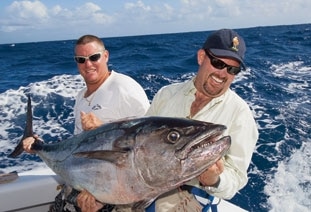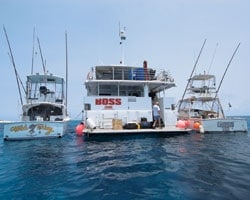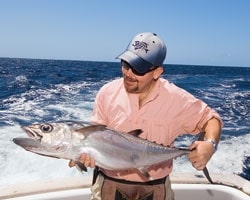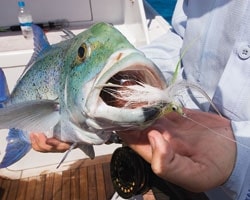
07dogtooth
Hal Chittum is no stranger to angling adventure.
Over the past 7 or 8 years, he’s been exploring the ragged edge of fly-, light- and heavy-tackle angling off Australia’s Great Barrier Reef. During that time he befriended top Aussie skipper, Hayden Bell. On his annual 40-day treks to chase wahoo, dogtooth tuna and black marlin with fly and conventional gear, Chittum heard Bell telling stories about a place called the Willis Islets, some 300 miles east of Cairns, Australia, in the Coral Sea.
It’s the stuff of legend: a group of deserted islands seldom – if ever – fished by recreational anglers. After two or three years of planning, Chittum decided to put a group of fishermen together to explore these uncharted waters. Of course when the invitation was extended to me, I had two questions: “When and where do I show up?”
And so it was that I found myself reclining in business class on an Air New Zealand 747, sipping a delightful Kiwi sauvignon blanc and contemplating what was ahead of me as part of a 10-angler group heading out to fish one of angling’s last, unexplored frontiers.
“This whole concept can only be likened to a three-month tent safari in Africa, a la Robert Ruark,” says Chittum. “The chance to fish someplace that has never been fished before is becoming rarer and rarer.”
And more expensive. The going rate on this trip was $37,000 per angler.

We arrived in Cairns in mid-November. Because of production deadlines, I was only able to stay for 10 days. My friend and angling partner, Beverly Hills art dealer Michael Schwartz, would be returning with me to Cairns from Willis via seaplane. The rest of the group, including Chittum, Keys guides John Donnell, John Kipp and RT Trosset, along with anglers Mike Monier and Buddy, Casey and Christian Sowers would spend a total of three weeks exploring virgin territory.
Our base of operations would be The Boss, an opulently appointed 78-foot mothership armed with two small skiffs, one fiberglass and one rigid-hull inflatable. We’d also have three game boats: Bell’s Don’t Ask Me; the Wild Turkey with Capt. Ben Bright and owner/mate Greg Simms; and the Pirate, skippered by Neil Marchant.
Slow Start – Not!
The last time I visited Australia nearly 15 years ago, I was greeted by the worst weather along the tropical Queensland coast in more than 40 years. It’s only fitting that upon my arrival – and the day we were supposed to begin the 300-mile trek to the Willis Group – an unseasonably early typhoon was threatening the region. Even at Cairns, the storm was kicking up a nasty swell and winds were gusting to more than 30 knots. Although it delayed our departure for the Willis Group, we decided to head to Flinder’s Reef. We left the dock mid-morning after loading more than 800 pounds of fishing tackle aboard. We arrived at the reef by mid-afternoon, leaving us just enough time to get a brief afternoon on the water. Trosset, Sowers, Schwartz and I boarded the Pirate.
Flinder’s, for those unfamiliar with the area, is one of the Great Barrier Reef’s legendary black marlin haunts. Although we tried traditional bait-and-switch techniques to see if we could tempt anything to the fly, it proved so rough that our fellow anglers wanted to go back to the mothership. After dropping the others off, I turned to Trosset.
“Here we are, best friends, in Australia on the Great Barrier Reef during the heart of the black marlin bite,” I said. “I am not going to sit on that mothership – we might never get here ever again. Let’s go catch a black on heavy tackle.”
With that, our crew got out the 130-pound outfits, several baits in the 15-pound range that would have put up quite a fight on a 10-weight, and away we went. The next hour and a half saw an epic marlin bite unfold; I pulled the hook on a 300-pounder and released a 350-pounder, and Trosset dropped a fish estimated by the crew at nearly 800 pounds after 20 minutes. Although many fly anglers might eschew heavy tackle, let me just say this: Catching one of these magnificent creatures on a 130-pound outfit that you can barely lift out of the rod holder while the fish is ripping off line faster than a red-lined Corvette is an experience every diehard angler should enjoy.
And I did. Immensely.
On to Willis
The weather finally abated, opening a window for us to make our way toward Willis. The crossing wasn’t without its moments, though. At one point The Boss took a green wave over the superstructure – at night – that was strong enough to knock me out of my bunk. Two days later we approached Willis Island, the main body of land in the group. Its sole inhabitants besides several thousand noddy terns and masked boobies are four meteorologists who maintain a weather station there. So seldom do the scientists get visitors that, when our flotilla arrived, they hailed us on the VHF radio to make sure we were OK.

As our crew got The Boss anchored, we decided to do a bit of exploratory trolling in the hopes of figuring out where the main body of dogtooth tuna might be located. Trosset and I split up, fishing on different boats; he on the Pirate with Sowers and I on the Wild Turkey with Schwartz. One of the dilemmas when exploring uncharted territory is where to fish. Our plan was to troll large swimming plugs on heavy tackle for a few hours to see if we could locate some doggies.
Less than 20 minutes after putting our lines out, I hooked a 92-pounder on 50-pound that will likely go down as one of my lifetime fish. I was feeling pretty cocky when we got back to The Boss to weigh my fish. That lasted right up to the moment when Trosset threw a 167-pounder up on the deck – a new 30-pound-line-class record and the 165th of his career. Sitting side by side, his looked like it could have eaten my fish.
But we didn’t come to fish heavy conventional tackle for doggies. We came to catch them on fly. And that, we did.
Doggies On Fly
Chittum is the world’s leading expert on chasing dogtooth tuna on fly, holding the 12- (50-pounds, 11-ounces), 16- (147 pounds, 14 ounces) and 20-pound (88 pounds, 2 ounces) IGFA tippet marks. His favored method of taking doggies involves bait-and-switch fishing with MoldCraft Wide Range lures and gigantic foam-tube poppers. You’ll usually get one or two shots at fish before they fade. Wrestling with a 20-weight fly rod and popping bugs that weigh several ounces is – to say the least – a macho effort.
The fish we encountered weren’t as aggressive as those Chittum found on previous trips to the Great Barrier Reef. Although he and his crew were getting bites, it seemed more like a Chinese fire drill for Schwartz and me. We’d get a bite but, by the time we wrestled the gigantic popper out to where the fish was and the teasers were cleared, the doggies were gone.
After two or three tries, I got frustrated and decided to go old-school. Capt. Bright and I held a strategy session.
“I want to try something different,” I said. “It seems like when you get this big bug out there, if the fish aren’t interested, you’re out of the game. Let’s go to a sinking fly and see if there’s anybody else around when we get the bite. If I don’t hook up immediately, keep the boat out of gear and let me fish the fly deep a couple of times and see what happens. I’ll bet when the teaser gets crashed, three or four other fish are swimming around down below looking for something to eat, and we’ll get a bite.”
We put the teasers back out and instantly raised a fish. Bright pulled the boat out of gear, Simms cleared the teasers and I fired a Puglisi tube fly armed with 7/0 Gamakatsu hooks towards the boil.
Nothing.
Sticking to our plan, I got the fly down 20 feet and then tucked the rod under my arm and started a quick double-handed striper strip. Halfway back to the boat, I got the bite. And what a bite it was!
The dogtooth tuna begins its battle with one of the most breathtaking, blistering horizontal runs in sport fishing. It’s like being attached to a Saturn V rocket heading sideways.
Getting the fish on the reel, I had to deal with the trademark vertical dive that comes next. The doggie ran off the edge of the reef, but Bright was able to keep the Turkey over the fish. It soon settled down into a typical bull-dogging tuna fight and, 20 minutes later, I had the doggie circling within reach of mate Greg Simms’ brawny grip. When we got the fish on board, I couldn’t believe it was only a 25-pounder. Pound for pound, it was one of the hardest-fighting fish I’ve ever caught.
Snapping a couple of photos, we iced that fish down for a little white-tuna sashimi (the dogtooth is an incredible eating fish, either as sashimi or grilled). Bright grinned from the bridge.
“I think we might be on to something here,” he beamed. We put the lures back out and got right back to it. Over the next few days we used the technique to take multiple dogtooth, hooking several hogs that we never had a hope of landing before they got us into the reef. After my departure, Trosset hooked a fish that took half a Tibor Pacific’s worth of backing – 750 yards of 50-pound PowerPro – before slicing the gelspun on the reef.
Other Species
The dogtooth weren’t the only bruisers we had a chance to tangle with. Casting sinking lines and half-and-half streamers over submerged coral heads produced bluefin trevally, coral trout, green jobfish, giant trevally (albeit small ones), several other unidentifiable species – and a bunch of shredded fly lines. One of the most interesting days saw me climbing aboard a small inflatable skiff and fishing patch reefs with Keys old hand John Donnell and fishing buddy Mike Monier. We stopped for lunch on a small sand spit where the duo had spotted a school of common darts (very similar to our Atlantic palometa) the day before.

Tying on a small crab pattern, we stalked the beach. We couldn’t find them until I spotted a 400-pound lemon shark cruising down the beach. Knowing how our fish in the Keys behave, I launched a 50-foot cast over the shark’s dorsal. Letting the small crab pattern settle, I stripped once and was on with one of the little scrappers.
I was afraid that the shark would turn on the fish, a perfect bite-sized meal. But, as it turned out, the sharks (four of them in all) were there for the cake – fledgling boobies and terns attempting to master the art flight – not the ice cream. We went on to have an enjoyable afternoon, releasing a dozen of the little guys before heading back in the skiff in search of larger prey.
Unfortunately, my 10-day odyssey came to an end before the best fishing of the trip. I didn’t want to board the Caravan seaplane for our two-hour flight back to Cairns, but I did. During the flight back, I reflected on what will likely be the most remote fishing trip I’ll ever go on – with good buddies and anglers who would become lifelong friends – and I can’t wait to go back.
Gear Guide
RODS: This trip required a variety of tackle, since we weren’t sure what we were going catch. For reef species 8- or 10-weight rods suffice. When chasing dogtooth (unless attempting to set light-tippet records), I’d opt for at least a 12-weight, and a 14- or 15-weight might be a better choice.
REELS: Large-arbor, DD reels capable of holding 200 yards of backing for reef species and 800 yards of backing for dogtooth
LEADERS: 12-pound or heavier is needed to wrestle reef fish away from the rocks and, with regard to dogtooth, there is no shame in going with 20-pound. Bite tippets of 40-pound mono or heavier are necessary for reef fish, while I’d recommend Malin’s Boa or hard wire in 60-pound or heavier to prevent bite-offs from doggies.
LINES: Density-compensated sinking lines like those made by Rio or Scientific Anglers in weights ranging from 350 grains to 700 grains are ideal.
FLIES: For reef species, nothing works better than a general selection of Clouser Deep Minnows, half-and-halfs or Deceivers. For dogtooth, I found several effective patterns, including Cam Sigler’s Tube Fly or Fish Fly, Enrico’s Tube Fly and Big Eye Bait Fish, as well as Robrahm’s Dark Day and Flying Fish patterns.
OTHER GEAR: Iridium satellite phone with laptop connection to stay in touch; Tibor LineMaster for changing fly lines and adding backing after getting shredded in the reef.









